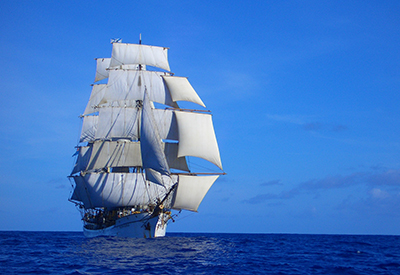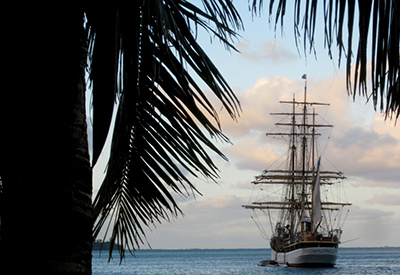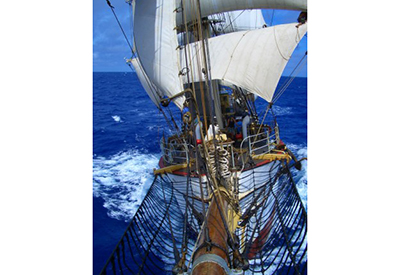Picton Castle embarks on her final world cruise

Apr 12, 2018
As you read this the barque Picton Castle is in the Gulf of Mexico on her way to the Panama Canal and her 7th circumnavigation of the world. Picton Castle has made her headquarters in Lunenburg for the last twenty years and is well known in our waters and at various Tall Ship events. On board Captain Dan Moreland will be taking a kind of farewell tour of the places he has visited and friends he has made over the past 40 plus years of ocean voyaging.
 While this may be her last world cruise, it does not mean the old ship will be retiring any time soon. Capt. Moreland told the CBC Picton Castle will be continuing to cruise the North Atlantic circuit to Europe and the West Indies, all the while serving as a platform for teaching seamanship skills to a new generation of seafarers.
While this may be her last world cruise, it does not mean the old ship will be retiring any time soon. Capt. Moreland told the CBC Picton Castle will be continuing to cruise the North Atlantic circuit to Europe and the West Indies, all the while serving as a platform for teaching seamanship skills to a new generation of seafarers.
The 90-year-old vessel had an interesting history even before she began her world travels. Here is her story from www.picton-castle.com :
 “The Picton Castle was built in 1928 as a Swansea fishing trawler (motorized) and for years operated out of Wales. She was one of five trawlers built at that time for the same company — all very modern for their day (the local paper reporting on her maiden voyage marveled over her electric lights and depth finder) — all named after castles. (The namesake castle is in Pembrokeshire in Wales and was built in the 11th century.)
“The Picton Castle was built in 1928 as a Swansea fishing trawler (motorized) and for years operated out of Wales. She was one of five trawlers built at that time for the same company — all very modern for their day (the local paper reporting on her maiden voyage marveled over her electric lights and depth finder) — all named after castles. (The namesake castle is in Pembrokeshire in Wales and was built in the 11th century.)
At the start of WWII, she was conscripted into the Royal Navy and became the HMS Picton Castle, a minesweeper. According to Tom Gamble, the radio operator who served aboard her during that time, “The minesweeper service lost more ships than any other branch of the Royal Navy as sweeping mines was very dangerous work. In fact, one day while on patrol a mine exploded under the ship and lifted her clean out of the water — all 300 tons of her. Fortunately, no real damage occurred.”
 Soon afterward, while sweeping mines in Norwegian waters, the Picton Castle developed a problem and it was determined that she would have to put into the nearest port: Bergen. The Germans had just decided to abandon Norway rather than fight and so decamped. The next day the HMS Picton Castle appeared in the harbor flying the Union Jack and has since been hailed by the Norwegian people as the “Liberator of Norway.”
Soon afterward, while sweeping mines in Norwegian waters, the Picton Castle developed a problem and it was determined that she would have to put into the nearest port: Bergen. The Germans had just decided to abandon Norway rather than fight and so decamped. The next day the HMS Picton Castle appeared in the harbor flying the Union Jack and has since been hailed by the Norwegian people as the “Liberator of Norway.”
After the war she eventually began hauling freight working in the North and Baltic Seas. She underwent a name change and for a while was known as the Dolmar. In 1992 and 1993, Captain Daniel Moreland was scouring various ports looking for a ship that could be converted into a square-rigger. He found the Picton Castle in a fjord in Norway. He and a small crew cleaned her, got the big 700 HP Burmeister and Wain diesel engine running, and took her across the Atlantic to New York City where she was berthed at the South Street Seaport Museum. In 1996, she was taken to Lunenburg in Nova Scotia, Canada, to begin a two-million-dollar refit. A clipper bow was welded in place, three steel masts added, and slowly — like a caterpillar undergoing metamorphosis — she became a square-rigged barque.
 The Picton Castle is 179 feet long, displaces 300 tons, and carries 12,500 square feet of sail. When her coed crew goes aloft to furl sail, they are working ten stories above the deck and they must come to master 175 different lines — and be able to handle them deftly on the blackest of nights. Participating in the ship’s sail-training program, the crew learns knotting ropes, sail making, celestial navigation, oceanography, meteorology and responsibility for all facets of maintenance. During her first world voyage (1997-1999), the ship was completely repainted four times and certain parts varnished ten times in 19 months.
The Picton Castle is 179 feet long, displaces 300 tons, and carries 12,500 square feet of sail. When her coed crew goes aloft to furl sail, they are working ten stories above the deck and they must come to master 175 different lines — and be able to handle them deftly on the blackest of nights. Participating in the ship’s sail-training program, the crew learns knotting ropes, sail making, celestial navigation, oceanography, meteorology and responsibility for all facets of maintenance. During her first world voyage (1997-1999), the ship was completely repainted four times and certain parts varnished ten times in 19 months.
During UNESCO’s “Year of the Ocean” in 1998, the Picton Castle served as flagship for the OCEAN98 organization. She distributed school supplies provided by NOAA and the EPA throughout the South Pacific. Later, she entered into a joint venture with SPREP (South Pacific Region Environment Program, which serves as a planning arm to 22 island nations) to deliver a variety of environmental course materials to schools in that vast area. At certain remote locations such as Pitcairn Island (where the descendants of the HMS Bounty mutineers still live) and Palmerston Island, her doctors would go ashore and set up medical clinics, working until all the inhabitants had been examined. Later, while in the Indian Ocean, Kate Menser and three other educators came aboard and sent educational programming back to some 2,000 schools in North America and around the world.
 As trawler, minesweeper, freighter, barque, and schoolroom, the Picton Castle has acquitted herself well as is the case when men and women live to serve their ship under sail.
As trawler, minesweeper, freighter, barque, and schoolroom, the Picton Castle has acquitted herself well as is the case when men and women live to serve their ship under sail.
Captain Daniel Moreland is one of the most respected sailing ship masters at sea today. An internationally recognized authority on square-rig and traditional sailing ships, he started his career sailing in the West Indies in island schooners, brigantines, and passenger windjammers.
He sailed around the world the first time in 1974–76 on the Brigantine Romance, under Captain Arthur Kimberly. In 1980, he signed on the famous Danish state full-rigged school ship Danmarkand served for four years training young officer cadets for the Danish merchant marine. His interest in learning, studying and teaching the value of traditional sail led him to head up the restoration of one of the last nineteenth-century Grand Banks fishing schooners, the Ernestina. For this he received the prestigious Honor Award from the National Trust for Historic Preservation in 1987.
In 1999, following the Picton Castle’s return from its first circumnavigation, Captain Moreland received the American Sail Training Association’s “Sail Trainer of the Year” award.
Captain Moreland has since completed four additional circumnavigations (2000–2002, 2003–2004, 2005-2006, 2010-2011) in the Picton Castle, along with many shorter voyages, and a year-long voyage around the Atlantic basin. In 2011, after the completion of his fifth circumnavigation in command of Picton Castle, he was recognized worldwide, being awarded “Sail Trainer of the Year” by Sail Training International.
On Saturday January 30, 2016 in Quebec City at the joint conference of Sail Training International and Tall Ships America, Captain Moreland was presented with the STI Lifetime Achievement Award, given to an individual who has dedicated his or her life’s work to getting people to sea under sail and who has worked to preserve the traditions and skills of sail training.
Captain Moreland holds the rarest license issued to Merchant Marine officers today: Master of Steam, Motor, or Auxiliary Sail, Vessels of Any Gross Tons upon Oceans. With 30 years at sea as master or mate of topsail schooners, brigantines, brigs, and barques making numerous transatlantic voyages and five circumnavigations, few are so well qualified to lead a voyage and train apprentice sailors.”
For more information contact:
Barque Picton Castle
P.O. Box 1076, 135 Bluenose Drive, Lunenburg, NS B0J 2C0
Phone: (902) 634-9984
Email: info@picton-castle.com or visit www.picton.castle.com





























